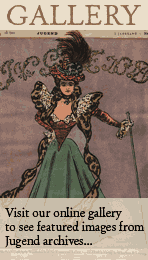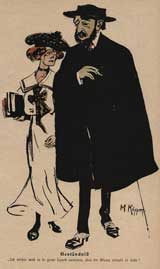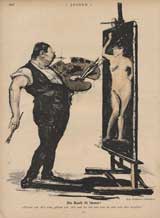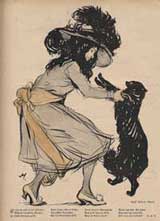Jugendstil Artists for Jugend
Jugendstil predated the magazine Jugend in Bavaria. The first major artist of the style was Emil Hansen (later called Nolde), who had been teaching ornamental design in St. Gall since January 1892. He met Georg Hirth in 1895, and discussed the paper Jugend with him. From this short meeting, Hansen was destined to design ornament after ornament for its pages. And artist after artist found his beginning in Jugend.
Hans Heinrich Christianson was well known as a graphic designer, painter, commercial artist, and decorative artist. He created several covers for Jugend, and was a frequent art contributor.
Hugo Hoppner, also called Fidus, was born in 1868 and trained in an artists commune in Munich. In 1892 he moved to Berlin to create another commune. His graphic art illustrations were known for dream-like abstractions. Jugend could depend on him for illustrations of German mythology, and he often combined mysticism, eroticism, and symbolism in Art Nouveau and Sezessionist styles graphically. He was one of the first German Jugendstil artists to use photo advertising postcards to promote his work; many others followed, leaving us a rich legacy of remarkable postcard images that are highly sought after by collectors.
Ernst Barlach was one of the great Jugendstil sculptors and illustrators, and he wrote plays as well. The Nazis ultimately condemned his work (and by extension, him) as degenerate. Examples of his work were The Reunion, showing St. Thomas recognizing Christ, which he labelled "Two Monkeys in Nightshirts." This was typical of his attitude, and he commonly eschewed Christian and historical tradition in favour of a style that combined late German Gothic art with German and Nordic folkways and mythology. His works are marked with archaic power, spiritualism and a dramatic angst. Barlach was born in Holstein, and educated in the Hamburg School of Arts and Crafts, then later at the Dresden Academy and in Paris. From 1898 to 1902, he worked for Jugend, and from 1901 to 1905 he designed ceramics in Wedel for the Muntz factory; his work here and privately transformed him into one of the leading Expressionist sculptors of Germany. Later he was deeply influenced by the great Russian writers, and his work deepened and broadened into the spiritual search for God and self. The grand war memorial he created at the Magdeburg Cathedral was controversial and powerful, and is probably what got him condemned by the Nazis as a "spoiler of art." Barlach died in 1938 in Rostock.
Peter Behrens was a German architect who did a good deal of art for Jugend in the early years of the publication. By 1903, however, he had moved to the Hessian artist colony of Darmstadt and toward a more sedate and conservative style of art.
Julius Klinger was a German artist of Jewish descent who worked for Jugend for several years from 1896 to 1903 at the beginning of his artistic career. He later went on to be a formative force in advertising art, and ultimately died during World War II, probably at the hands of the Nazis.
Heinrich Kley, of all the Jugend artists, may have the most far-reaching legacy. Walt Disney was a fan of his fantastic and rather dark images, and had an extensive collection. Kley's art was inspirational in Disney's early works, most notably in Fantasia, arguably a movie that fans of Jugend would have approved of.





